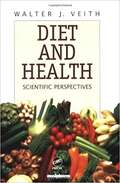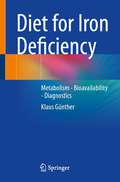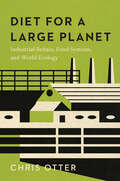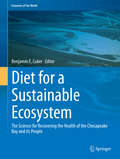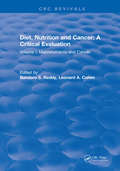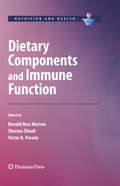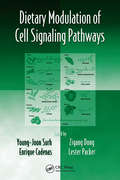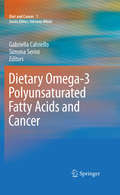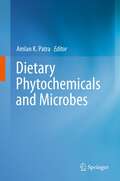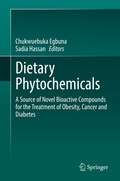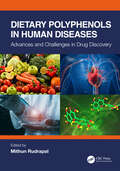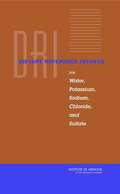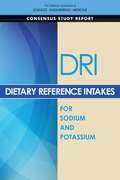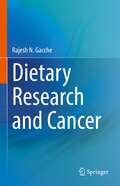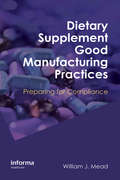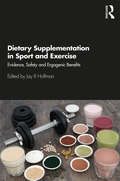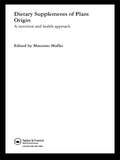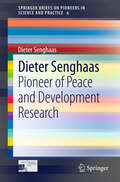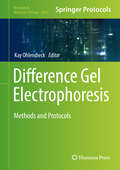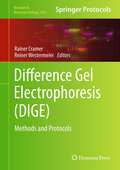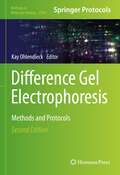- Table View
- List View
Diet Quality: An Evidence-Based Approach, Volume 1
by Victor R. Preedy Vinood B. Patel Lan-Anh HunterDiet quality is a broad term that encapsulates both perceived and actual practices, personal preferences and cultural diversity. Measuring dietary quality can be problematic and includes investigating food types, the number or size of portions or their frequency. Diet quality may also be related to the type of food being ingested, snacking and other eating habits. Manufactured beverages and fast food may also be included as well as microbiological quality and attempts to improve single food items such as meats or vegetables. In this book, Diet Quality: An Evidence-Based Approach, Volume 1 all of the major facets of diet quality in relation to health outcomes are covered. This important new text includes methods for determining diet quality while adopting a holistic approach to impart information on the major areas of concern or knowledge. Chapters link in measurable indices of health such as obesity, pregnancy outcomes, cancer and cancer outcomes, and mortality. This book represents a diverse set of subject matters and seeks to fill a gap in the literature at a time when there is an increasing awareness that well being is associated with the qualitative nature of diets. Contributors are authors of international and national standing and emerging fields of science are incorporated. Diet Quality: An Evidence-Based Approach, Volume 1 is a useful new text designed for nutritionists, dietitians, clinicians, epidemiologist, policy makers and health care professionals of various disciplines.
Diet and Health: Scientific Perspectives
by Walter J. VeithUniv. of Cape Town, South Africa teviews the latest findings and describes the causes of degenerative human diseases. Supplies information on how to implement an alternative lifestyle. Concludes with a special recipe section. For the nutritionist and consumer.
Diet for Iron Deficiency: Metabolism - Bioavailability - Diagnostics
by Klaus GüntherAround a quarter of the world's population is affected by iron deficiency, and women of childbearing age as well as children and adolescents are considered a particular risk group. This reference book deals with the latest scientific findings concerning the iron supply of the human organism with natural foods. It dispels the misconception that plant iron is less valuable than animal iron by presenting the absorption of iron from plant foods via a newly discovered metabolic pathway. From this, new points of view can be derived for vegetarians and vegans, who until now have belonged to the risk group. Furthermore, it is dedicated to forward-looking possibilities of diagnosing iron deficiency and describes modern concepts for determining the bioavailability of iron in food. New findings on the biochemistry of iron in brain metabolism, the description of the different reference values of the international professional societies and practical advice for special diets, risk groups and age groups as well as cooking recipes with simple information on iron intake complete the work. The book is aimed at nutritionists and medical practitioners, nutrition and food scientists, dieticians, pharmacists and sports scientists.
Diet for a Large Planet: Industrial Britain, Food Systems, and World Ecology
by Chris OtterWe are facing a world food crisis of unparalleled proportions. Our reliance on unsustainable dietary choices and agricultural systems is causing problems both for human health and the health of our planet. Solutions from lab-grown food to vegan diets to strictly local food consumption are often discussed, but a central question remains: how did we get to this point? In Diet for a Large Planet, Chris Otter goes back to the late eighteenth century in Britain, where the diet heavy in meat, wheat, and sugar was developing. As Britain underwent steady growth, urbanization, industrialization, and economic expansion, the nation altered its food choices, shifting away from locally produced plant-based nutrition. This new diet, rich in animal proteins and refined carbohydrates, made people taller and stronger, but it led to new types of health problems. Its production also relied on far greater acreage than Britain itself, forcing the nation to become more dependent on global resources. Otter shows how this issue expands beyond Britain, looking at the global effects of large agro-food systems that require more resources than our planet can sustain. This comprehensive history helps us understand how the British played a significant role in making red meat, white bread, and sugar the diet of choice—linked to wealth, luxury, and power—and shows how dietary choices connect to the pressing issues of climate change and food supply.
Diet for a Sustainable Ecosystem: The Science for Recovering the Health of the Chesapeake Bay and its People (Estuaries of the World)
by Benjamin E. CukerThis book explores a specific ecosystem in depth, in order to weave a story built on place and history. It incorporates the theme of a journey to help reveal the environment-human-health-food system-problem. While drawing on a historical approach stretching back to the American colonial era, it also incorporates more contemporary scientific findings. By crafting its story around a specific place, the book makes it easier for readers to relate to the content, and to subsequently use what they learn to better understand the role of food systems at the global scale.
Diet, Brain, Behavior: Practical Implications
by Robin B. Kanarek Harris R. LiebermanAs the field of nutritional neuroscience has grown, both the scientific community and the general population have expressed a heightened interest in the effect of nutrients on behavior. Diet, Brain, Behavior: Practical Implications presents the work of a diverse group of scientists who collectively explore the broad scope of research in the field.T
Diet, Nutrition and Cancer: Volume I
by Bandaru S. ReddyThese two volumes bring together a wide variety of studies concerning the role nutrition plays in the etiology of various types of cancer, namely, cancer of the esophagus, upper alimentary tract, pancreas, liver, colon, breast, and prostate. The purpose of each chapter is to provide a critical interpretive review of the area, to identify gaps and inconsistencies in present knowledge, and to suggest new areas for future research.
Diet, Nutrition and Cancer: Volume II
by Bandaru S. ReddyThese two volumes bring together a wide variety of studies concerning the role nutrition plays in the etiology of various types of cancer, namely, cancer of the esophagus, upper alimentary tract, pancreas, liver, colon, breast, and prostate. The purpose of each chapter is to provide a critical interpretive review of the area, to identify gaps and inconsistencies in present knowledge, and to suggest new areas for future research.
Dietary Components and Immune Function
by Victor R. Preedy Ronald Ross Watson Sherma ZibadiDietary Components and Immune Function focuses on immune modulation, immune mediated disease resistance, immune changes due to AIDS, immune modulated cancer therapy, and autoimmune diseases as modified by dietary supplement, bioactive foods and supplements. The potential value of such approaches in maintaining wellness and preventing disease are addressed by examining their effects in vitro and in vivo on innate and adaptive immune responses. Emerging fields of science and important discoveries relating to early stages of new nutriceuticals in cancer prevention, prior to clinical trials are also covered. This volume represents a single source of material related to nutriceuticals and their constituents as they relate to cancer therapy and prevention. As such the book will be essential reading for nutritionists, pharmacologists, health care professionals, research scientists, cancer workers, pathologists, molecular or cellular biochemists, physicians, general practitioners as well as those interested in diet and nutrition in disease resistance via immune regulation.
Dietary Modulation of Cell Signaling Pathways (Oxidative Stress and Disease)
by Zigang Dong Enrique Cadenas Lester Packer Young-Joon SurhA consequence of rapid progress in the science of nutrigenomics and nutrigenetics is the substantial accumulation of data covering nutrienal modulation of gene expression at the cellular and subcellular levels. Current research is increasingly focused on the role of nutrition and diet in modifying oxidative damage in the progression of disease. Die
Dietary Omega-3 Polyunsaturated Fatty Acids and Cancer
by Simona Serini Gabriella CalvielloDietary Omega-3 Polyunsaturated Fatty Acids and Cancer provides all the latest information on the possible benefits of omega-3 polyunsaturated fatty acids (PUFAs) against a wide series of cancers. Several influential scientists in this field have contributed to make this book unique amongst the others published so far in this field. The chapters give detailed information about the results obtained in this field through experimental studies conducted on both animals and cultured cells, as well as through human intervention trials and epidemiological observational studies. This book represents an important tool for researchers working in nutrition and oncology, since it collects all the knowledge about omega-3 PUFAs and cancer, even the most recent, in a single publication. For the first time controversies among the different studies are also covered with great detail in this book. The book enables physicians to clearly understand on a scientific basis if their oncologic patients or patients at risk of cancer could actually benefit from a diet enriched in omega-3 PUFAs or from a dietary supplementation with these fatty acids. The book represents also a good resource for ordinary individuals as well as cancer patients to learn more about omega-3 PUFAs and understand how these dietary components may affect cancer growth.
Dietary Patterns, Food Chemistry and Human Health (SpringerBriefs in Molecular Science)
by Michele Barone Suresh D. SharmaThis brief discusses the influence of modern food production on dietary patterns and chronic diseases. In four concise chapters the authors explore different aspects of this topical issue. Chapter one highlights the importance of advanced glycation end products in food and describes how high levels of these complex molecules can lead to an increase in chronic diseases. Chapter two addresses the role of carbohydrates in inexpensive and tasty foods, while chapter three outlines how vegetable fats, notably palm oil, are used in selected industrial foods and explores their relation to hyper-palatability and other health issues. Lastly, the fourth chapter discusses the increasing demand for high-protein foods and the concomitant availability of vegan products. This brief is of interest to researchers in food production, food hygiene and public health, but is also relevant for certification bodies and specialists in the food industry.
Dietary Phytochemicals and Microbes
by Amlan K. PatraHumans have utilized the bioactive principles of different plants for various beneficial physiological properties including antimicrobial properties for many centuries. However, interests of using medicinal plants declined in the 20th century with the availability of effective synthetic antimicrobial drugs. The development of microbial resistance to various drugs has accelerated research interests towards the use of phytochemicals as alternatives to synthetic drugs in the recent years. This book presents an comprehensive reviews on the antimicrobial and antiviral properties of numerous recently reported phytochemicals, and their mechanisms of antimicrobial actions. Some of the chapters have critically discussed the beneficial and adverse effects of antibacterial, and stimulatory activities of dietary phytochemicals on rumen microbial populations, and gut microbial populations of humans and animals. Microbial adaptation and resistance of microbes to phytochemicals has also been highlighted. On the applied apects, the use of phytochemicals against drug resistance microbes, to treat microbial diseases, for food preservation, to inhibit methanogenic archaea in the rumen, and to modulate lipid biohydrogenating microbial populations to increase conjugated linoleic acids in animal-derived foods have been presented in different chapters.
Dietary Phytochemicals: A Source of Novel Bioactive Compounds for the Treatment of Obesity, Cancer and Diabetes
by Chukwuebuka Egbuna Sadia HassanThis book presents comprehensive coverage on the importance of good nutrition in the treatment and management of obesity, cancer and diabetes. Naturally occurring bioactive compounds are ubiquitous in most dietary plants available to humans and provide opportunities for the management of diseases. The text provides information about the major causes of these diseases and their association with nutrition. The text also covers the role of dietary phytochemicals in drug development and their pathways. Later chapters emphasize novel bioactive compounds as anti-diabetic, anti-cancer and anti-obesity agents and describe their mechanisms to regulate cell metabolism. Written by global team of experts, Dietary Phytochemicals: A Source of Novel Bioactive Compounds for the Treatment of Obesity, Cancer and Diabetes describes the potentials of novel phytochemicals, their sources, and underlying mechanism of action. The chapters were drawn systematically and incorporated sequentially to facilitate proper understanding. This book is intended for nutritionists, physicians, medicinal chemists, drug developers in research and development, postgraduate students and scientists in area of nutrition and life sciences.
Dietary Polyphenols in Human Diseases: Advances and Challenges in Drug Discovery
by Mithun RudrapalDiets rich in plant polyphenols or dietary polyphenols are the subject of increasing scientific interest because of their diverse range of health benefits and medicinal uses. This book, Dietary Polyphenols in Human Diseases: Advances and Challenges in Drug Discovery, fills the gap that exists in the current knowledge by presenting the latest information in the area of polyphenol-based drug discovery research. The book focuses on the current understanding of the beneficial effects on human health of diets rich in polyphenols and/or polyphenolic compounds derived from dietary sources (plant-based foods) and their possible preventive role in the management of chronic human diseases. In addition, biochemical mechanisms involved in the antioxidative effect of dietary polyphenols along with their bioavailability, pharmacokinetic, and toxicological considerations are also discussed herein. Key Features Presents health benefits and medicinal importance of dietary polyphenols having antioxidative effects and their possible preventive role against oxidative stress (OS)-induced chronic human diseases. Summarizes the latest understanding of the biochemical mechanism(s) involved in the antioxidative action of dietary polyphenols along with their bioavailability, pharmacokinetic, and toxicological considerations. Highlights novel approaches of drug discovery from dietary polyphenols through computational screening of bioactive phytochemical components. With contributions by a global team of experts (academics, scientists, and researchers), this book is intended to be a useful resource for a wider audience, particularly those working in the area of drug discovery and development research, such as discovery scientists, pharmaceutical scientists (R&D), formulation scientists, medicinal chemists, pharmacologists, toxicologists, phytochemists, biochemists, clinicians, researchers, students, teachers, and many others.
Dietary Reference Intakes for Water, Potassium, Sodium, Chloride, and Sulfate
by Panel on Dietary Reference Intakes for Electrolytes WaterThe Dietary Reference Intakes (DRIs) are quantitative estimates of nutrient intakes to be used for planning and assessing diets for healthy people. This new report, the sixth in a series of reports presenting dietary reference values for the intakes of nutrients by Americans and Canadians, establishes nutrient recommendations on water, potassium, and salt for health maintenance and the reduction of chronic disease risk. Dietary Reference Intakes for Water, Potassium, Sodium, Chloride, and Sulfate discusses in detail the role of water, potassium, salt, chloride, and sulfate in human physiology and health. The major findings in this book include the establishment of Adequate Intakes for total water (drinking water, beverages, and food), potassium, sodium, and chloride and the establishment of Tolerable Upper Intake levels for sodium and chloride. The book makes research recommendations for information needed to advance the understanding of human requirements for water and electrolytes, as well as adverse effects associated with the intake of excessive amounts of water, sodium, chloride, potassium, and sulfate. This book will be an invaluable reference for nutritionists, nutrition researchers, and food manufacturers.
Dietary Reference Intakes for Sodium and Potassium (Dietary Reference Intakes Ser.)
by Engineering Medicine National Academies of SciencesAs essential nutrients, sodium and potassium contribute to the fundamentals of physiology and pathology of human health and disease. In clinical settings, these are two important blood electrolytes, are frequently measured and influence care decisions. Yet, blood electrolyte concentrations are usually not influenced by dietary intake, as kidney and hormone systems carefully regulate blood values. Over the years, increasing evidence suggests that sodium and potassium intake patterns of children and adults influence long-term population health mostly through complex relationships among dietary intake, blood pressure and cardiovascular health. The public health importance of understanding these relationships, based upon the best available evidence and establishing recommendations to support the development of population clinical practice guidelines and medical care of patients is clear. This report reviews evidence on the relationship between sodium and potassium intakes and indicators of adequacy, toxicity, and chronic disease. It updates the Dietary Reference Intakes (DRIs) using an expanded DRI model that includes consideration of chronic disease endpoints, and outlines research gaps to address the uncertainties identified in the process of deriving the reference values and evaluating public health implications.
Dietary Research and Cancer
by Rajesh N. GaccheThis book reviews all important aspects of dietary research associated with cancer with the aim of shedding new light on these conditions through combined understanding of traditional and new paradigms. The book is divided into 17 chapters, the first portion reinterprets healthy diets for cancer based on up-to-date evidence from a network science perspective, examining the dietary patterns, outcome of diet related clinical trials, emerging framework of molecular mechanisms and interactions of dietary interventions and their applications in personalized diet, ground realities of benefits and regulatory frame work for functional foods, nutraceuticals and supplements in cancer prevention and upcoming future prospectus in diet-cancer research.. The later part of the book discusses recent advances in understanding of the elaborative discourse on cancer and fasting, covering, for example, calorie restriction and fasting mimicking diet. Finally, different Dietary research and approaches are considered in the context of novel intervention for cancer research. Dietary Research in Cancer will be of interest for all researchers, nutritionists, students and clinicians in the field.
Dietary Supplement Good Manufacturing Practices: Preparing for Compliance
by William J. MeadDietary Supplement GMP is a one-stop "how-to" road map to the final dietary supplement GMP regulations recently issued by the FDA covering the manufacture, packaging, and holding of dietary supplement products.The recent regulations, outlining broad goals, intentionally avoid specifics to allow for future technological advances-leaving implementati
Dietary Supplementation in Sport and Exercise: Evidence, Safety and Ergogenic Benefits
by Jay R HoffmanDietary Supplementation in Sport and Exercise removes the myths associated with many dietary supplements. It provides an evidence-based approach to the physiological mechanisms related to popular supplements and examines the ergogenic benefits in both competitive and recreational athletes. <P><P> This text covers a variety of supplements, including vitamins and minerals, carbohydrates, protein and amino acids, beta-alanine, creatine and guanidinoacetic acid, caffeine and probiotics, as well as emerging ergogenic aids. Information on dosage, ceiling effects and washout periods is discussed, along with safety and legality for different sporting organizations. The book also offers an insight into the efficacy of certain dietary supplements in unique populations, like children and the elderly. Dietary Supplementation in Sport and Exercise is an important resource for advanced undergraduate and graduate students on exercise science, health and nutrition courses, as well as strength coaches, athletic trainers, nutritionists and personal trainers, and medical professionals who consult with patients on dietary supplementation.
Dietary Supplements of Plant Origin: A Nutrition and Health Approach
by Massimo MaffeiDietary supplements are estimated to be used regularly by almost 60% of the American population, and over 300 million people worldwide. An important and ever-growing portion of this market is in botanical supplements that are derived from natural plants. Natural, however, does not necessarily mean safe, and although plants can provide health-essent
Dieter Senghaas
by Dieter SenghaasDieter Senghaas, professor emeritus of international relations, University of Bremen, was one of most innovative contemporary German social scientists, with major contributions on peace and development research and on music and peace. He was awarded many prizes: the International Peace Research Award (1987), Göttingen Peace Prize (1999), Culture and Peace Prize of the Villa Ichon in Bremen (2006), and the Leopold-Kohr Prize of the Austrian Ministry of Science and Research (2010). In addition to his autobiographic notes and his selected bibliography, this book offers a global audience five key texts by D. Senghaas (1974-2009): Towards an Analysis of Threat Policy in International Relations; Friedrich List and the Basic Problems of Development; Developing the Definitions of Perpetual Peace ('para pacem'): Through What and How is Peace Constituted Today?; Sounds of Peace: On Peace Fantasies and Peace Offerings in Classical Music; and Enhancing Human Rights - A Contribution to Viable Peace.
Difference Gel Electrophoresis
by Kay OhlendieckThis volume provides a comprehensive study of this key method of gel-based proteomics. Chapters in Difference Gel Electrophoresis: Methods and Protocols detail methods on principles of differential protein labeling, two-dimensional gel electrophoresis, techniques on optimized proteomic workflows, advanced mass spectrometry for protein identification, application of basic biological research, and applied biomarker discovery. Written in the highly successful Methods in Molecular Biology series format, chapters include introductions to their respective topics, lists of the necessary materials and reagents, step-by-step readily reproducible laboratory protocols, and tips on troubleshooting and avoiding known pitfalls. Authoritative and cutting-edge, Difference Gel Electrophoresis: Methods and Protocols aims to ensure successful results in the further study of this vital field.
Difference Gel Electrophoresis (DIGE)
by Rainer Cramer Reiner WestermeierProtein analysis is increasingly becoming a cornerstone in deciphering the molecular mechanisms of life. Proteomics, the large-scale and high-sensitivity analysis of proteins, is already pivotal to the new life sciences such as Systems Biology and Systems Medicine. Proteomics, however, relies heavily on the past and future advances of protein purification and analysis methods. DIGE, being able to quantify proteins in their intact form, is one of a few methods that can facilitate this type of analysis and still provide the protein isoforms in an MS-compatible state for further identification and characterization with high analytical sensitivity. Differential Gel Electrophoresis: Methods and Protocols introduces the concept of DIGE and its advantages in quantitative protein analysis. It provides detailed protocols and important notes on the practical aspects of DIGE with both generic and specific applications in the various areas of Quantitative Proteomics. Divided into four concise sections, this detailed volume opens with the basics of DIGE, the technique and its practical details with a focus on the planning of a DIGE experiment and its data analysis. The next section introduces various DIGE methods from those employed by scientists world-wide to more novel methods, providing a glance at what is on the horizon in the DIGE world. The volume closes with an overview of the wide range of DIGE applications from Clinical Proteomics to Animal, Plant, and Microbial Proteomics applications. Written in the highly successful Methods in Molecular BiologyTM series format, chapters contain introductions to their respective topics, lists of the necessary materials and reagents, step-by-step, readily reproducible laboratory protocols, and notes on troubleshooting and avoiding known pitfalls. Authoritative and accessible, Differential Gel Electrophoresis: Methods and Protocols can be used by novices with some background in biochemistry or molecular biology as well as by experts in Proteomics who would like to deepen their understanding of DIGE and its employment in many hyphenations and application areas. With its many protocols, applications, and methodological variants, it is also a unique reference for all who seek fundamental details on the working principle of DIGE and ideas for possible future uses of DIGE in novel analytical approaches.
Difference Gel Electrophoresis: Methods and Protocols (Methods in Molecular Biology #2596)
by Kay OhlendieckThe second edition of this volume provides a comprehensive update of this key method on gel-based proteomics. Chapters present an introduction into the development of methods on principles of differential protein labeling and two-dimensional gel electrophoresis, techniques on optimized proteomic workflows using advanced mass spectrometry for protein identification, and the application of those methods in basic biological research, pathobiology and applied biomarker discovery. Written in the highly successful Methods in Molecular Biology series format, chapters include introductions to their respective topics, lists of the necessary materials and reagents, step-by-step readily reproducible laboratory protocols, and tips on troubleshooting and avoiding known pitfalls. Authoritative and cutting-edge, Difference Gel Electrophoresis: Methods and Protocols, Second Edition aims to ensure successful results in the further study of this vital field.

